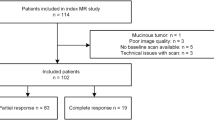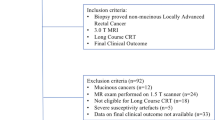Abstract
Purpose
The aim of this study was to build an appropriate diagnostic model for predicting pathological complete response (pCR) after neoadjuvant chemoradiotherapy (nCRT) in patients with locally advanced rectal cancer (LARC), by combining magnetic resonance imaging (MRI) parameters with clinical factors.
Methods
Eighty-four patients with LARC who underwent MR examination before and after nCRT were enrolled in this study. MRI parameters including cylindrical approximated tumor volume (CATV) and relative signal intensity of tumor (rT2wSI) were measured; corresponding reduction rates (RR) were calculated; and MR tumor regression grade (mrTRG) and other conventional MRI parameters were assessed. Logistic regression with lasso regularization was performed and the appropriate prediction model for pCR was built up. An external cohort of thirty-six patients was used as the validation group for testing the model. Receiver-operating characteristic (ROC) analysis was used to assess the diagnostic performance.
Results
In the development and the validation group, 17 patients (20.2%) and 11 patients (30.6%), respectively, achieved pCR. Two CATV-related parameters (CATVpost, which is the CATV measured after nCRT and CATVRR), one rT2wSI-related parameter (rT2wSIRR), and mrTRG were the most important parameters for predicting pCR and were retained in the diagnostic model. In the development group, the area under the receiver-operating characteristic curve (AUC) for predicting pCR is 0.88 [95% confidence interval (CI) 0.78–0.97, p < 0.001], with a sensitivity of 82.4% and a specificity of 83.6%. In the validation group, the AUC is 0.84 (95% CI 0.70–0.98, p = 0.001), with a sensitivity of 81.8% and a specificity of 76.0%.
Conclusion
A diagnostic model including CATVpost, CATVRR, rT2wSIRR, and mrTRG was useful for predicting pCR after nCRT in patients with LARC and may be used as an effective organ-preservation strategy.




Similar content being viewed by others
Abbreviations
- ADC:
-
Apparent diffusion coefficient
- CP:
-
Circumferential percentage
- CATV:
-
Cylindrical approximated tumor volume
- CATVRR:
-
The reduction rate of cylindrical approximated tumor volume
- DTA:
-
Distance from tumor to anal verge
- EMVI:
-
Extramural venous invasion
- LARC:
-
Locally advanced rectal cancer
- MRF:
-
Mesorectal fascia
- mrTRG:
-
Magnetic resonance tumor regression grading
- nCRT:
-
Neoadjuvant chemoradiotherapy
- pCR:
-
Pathological complete response
- rT2wSI:
-
Relative signal intensity of tumor
- rT2wSIRR:
-
The reduction rate of relative signal intensity of tumor
- TME:
-
Total mesorectal excision
- TP:
-
Tumor position
References
Sauer R, Liersch T, Merkel S, et al. (2012) Preoperative versus postoperative chemoradiotherapy for locally advanced rectal cancer: results of the German CAO/ARO/AIO-94 randomized phase III trial after a median follow-up of 11 years. Journal of clinical oncology: official journal of the American Society of Clinical Oncology 30(16):1926–1933. https://doi.org/10.1200/jco.2011.40.1836
Maas M, Nelemans PJ, Valentini V, et al. (2010) Long-term outcome in patients with a pathological complete response after chemoradiation for rectal cancer: a pooled analysis of individual patient data. The Lancet Oncology 11(9):835–844. https://doi.org/10.1016/s1470-2045(10)70172-8
Hotker AM, Tarlinton L, Mazaheri Y, et al. (2016) Multiparametric MRI in the assessment of response of rectal cancer to neoadjuvant chemoradiotherapy: A comparison of morphological, volumetric and functional MRI parameters. European Radiology 26(12):4303–4312. https://doi.org/10.1007/s00330-016-4283-9
Renehan AG, Malcomson L, Emsley R, et al. (2016) Watch-and-wait approach versus surgical resection after chemoradiotherapy for patients with rectal cancer (the OnCoRe project): a propensity-score matched cohort analysis. The Lancet Oncology 17(2):174–183. https://doi.org/10.1016/s1470-2045(15)00467-2
Sartori CA, Sartori A, Vigna S, Occhipinti R, Baiocchi GL (2011) Urinary and sexual disorders after laparoscopic TME for rectal cancer in males. Journal of gastrointestinal surgery: official journal of the Society for Surgery of the Alimentary Tract 15(4):637–643. https://doi.org/10.1007/s11605-011-1459-0
Braendengen M, Tveit KM, Bruheim K, et al. (2011) Late patient-reported toxicity after preoperative radiotherapy or chemoradiotherapy in nonresectable rectal cancer: results from a randomized Phase III study. International journal of radiation oncology, biology, physics 81(4):1017–1024. https://doi.org/10.1016/j.ijrobp.2010.07.007
Tarallo N, Angeretti MG, Bracchi E, et al. (2018) Magnetic resonance imaging in locally advanced rectal cancer: quantitative evaluation of the complete response to neoadjuvant therapy. Polish journal of radiology 83:e600–e609. https://doi.org/10.5114/pjr.2018.81156
Kluza E, Rozeboom ED, Maas M, et al. (2013) T2 weighted signal intensity evolution may predict pathological complete response after treatment for rectal cancer. European radiology 23(1):253–261. https://doi.org/10.1007/s00330-012-2578-z
Enkhbaatar NE, Inoue S, Yamamuro H, et al. (2018) MR Imaging with Apparent Diffusion Coefficient Histogram Analysis: Evaluation of Locally Advanced Rectal Cancer after Chemotherapy and Radiation Therapy. Radiology 288(1):129–137. https://doi.org/10.1148/radiol.2018171804
Battersby NJ, Dattani M, Rao S, et al. (2017) A rectal cancer feasibility study with an embedded phase III trial design assessing magnetic resonance tumour regression grade (mrTRG) as a novel biomarker to stratify management by good and poor response to chemoradiotherapy (TRIGGER): study protocol for a randomised controlled trial. Trials 18(1):394. https://doi.org/10.1186/s13063-017-2085-2
Lambregts DMJ, Boellaard TN, Beets-Tan RGH (2019) Response evaluation after neoadjuvant treatment for rectal cancer using modern MR imaging: a pictorial review. Insights into imaging 10(1):15. https://doi.org/10.1186/s13244-019-0706-x
Kim YH, Kim DY, Kim TH, et al. (2005) Usefulness of magnetic resonance volumetric evaluation in predicting response to preoperative concurrent chemoradiotherapy in patients with resectable rectal cancer. International journal of radiation oncology, biology, physics 62(3):761–768. https://doi.org/10.1016/j.ijrobp.2004.11.005
Bernier L, Balyasnikova S, Tait D, Brown G (2018) Watch-and-Wait as a Therapeutic Strategy in Rectal Cancer. Current colorectal cancer reports 14(2):37–55. https://doi.org/10.1007/s11888-018-0398-5
Sclafani F, Brown G, Cunningham D, et al. (2017) Comparison between MRI and pathology in the assessment of tumour regression grade in rectal cancer. Br J Cancer 117(10):1478–1485. https://doi.org/10.1038/bjc.2017.320
Park SH, Lim JS, Lee J, et al. (2017) Rectal Mucinous Adenocarcinoma: MR Imaging Assessment of Response to Concurrent Chemotherapy and Radiation Therapy-A Hypothesis-generating Study. Radiology 285(1):124–133. https://doi.org/10.1148/radiol.2017162657
Quirke P, Durdey P, Dixon MF, Williams NS (1986) Local recurrence of rectal adenocarcinoma due to inadequate surgical resection. Histopathological study of lateral tumour spread and surgical excision. Lancet (London, England) 2 (8514):996-999
Smith NJ, Barbachano Y, Norman AR, et al. (2008) Prognostic significance of magnetic resonance imaging-detected extramural vascular invasion in rectal cancer. The British journal of surgery 95(2):229–236. https://doi.org/10.1002/bjs.5917
Patel UB, Taylor F, Blomqvist L, et al. (2011) Magnetic resonance imaging-detected tumor response for locally advanced rectal cancer predicts survival outcomes: MERCURY experience. Journal of clinical oncology: official journal of the American Society of Clinical Oncology 29(28):3753–3760. https://doi.org/10.1200/jco.2011.34.9068
Neri E, Guidi E, Pancrazi F, et al. (2015) MRI tumor volume reduction rate vs tumor regression grade in the pre-operative re-staging of locally advanced rectal cancer after chemo-radiotherapy. European journal of radiology 84(12):2438–2443. https://doi.org/10.1016/j.ejrad.2015.08.008
Yeo SG, Kim DY, Park JW, et al. (2012) Tumor volume reduction rate after preoperative chemoradiotherapy as a prognostic factor in locally advanced rectal cancer. International journal of radiation oncology, biology, physics 82(2):e193–199. https://doi.org/10.1016/j.ijrobp.2011.03.022
Seierstad T, Hole KH, Groholt KK, et al. (2015) MRI volumetry for prediction of tumour response to neoadjuvant chemotherapy followed by chemoradiotherapy in locally advanced rectal cancer. The British journal of radiology 88(1051):20150097. https://doi.org/10.1259/bjr.20150097
Siddiqui MR, Gormly KL, Bhoday J, et al. (2016) Interobserver agreement of radiologists assessing the response of rectal cancers to preoperative chemoradiation using the MRI tumour regression grading (mrTRG). Clinical radiology 71(9):854–862. https://doi.org/10.1016/j.crad.2016.05.005
Fayaz MS, Demian GA, Fathallah WM, et al. (2016) Significance of Magnetic Resonance Imaging-Assessed Tumor Response for Locally Advanced Rectal Cancer Treated With Preoperative Long-Course Chemoradiation. Journal of global oncology 2(4):216–221. https://doi.org/10.1200/jgo.2015.001479
Yu SK, Tait D, Chau I, Brown G (2013) MRI predictive factors for tumor response in rectal cancer following neoadjuvant chemoradiation therapy–implications for induction chemotherapy? International journal of radiation oncology, biology, physics 87(3):505–511. https://doi.org/10.1016/j.ijrobp.2013.06.2052
Garland ML, Vather R, Bunkley N, Pearse M, Bissett IP (2014) Clinical tumour size and nodal status predict pathologic complete response following neoadjuvant chemoradiotherapy for rectal cancer. International journal of colorectal disease 29(3):301–307. https://doi.org/10.1007/s00384-013-1821-7
Wallin U, Rothenberger D, Lowry A, Luepker R, Mellgren A (2013) CEA - a predictor for pathologic complete response after neoadjuvant therapy for rectal cancer. Diseases of the colon and rectum 56(7):859–868. https://doi.org/10.1097/DCR.0b013e31828e5a72
Huh JW, Kim HR, Kim YJ (2013) Clinical prediction of pathological complete response after preoperative chemoradiotherapy for rectal cancer. Diseases of the colon and rectum 56(6):698–703. https://doi.org/10.1097/DCR.0b013e3182837e5b
Armstrong D, Raissouni S, Price Hiller J, et al. (2015) Predictors of Pathologic Complete Response After Neoadjuvant Treatment for Rectal Cancer: A Multicenter Study. Clinical colorectal cancer 14(4):291–295. https://doi.org/10.1016/j.clcc.2015.06.001
Yang KL, Yang SH, Liang WY, et al. (2013) Carcinoembryonic antigen (CEA) level, CEA ratio, and treatment outcome of rectal cancer patients receiving pre-operative chemoradiation and surgery. Radiation oncology (London, England) 8:43. https://doi.org/10.1186/1748-717x-8-43
Kim S, Han K, Seo N, et al. (2018) T2-weighted signal intensity-selected volumetry for prediction of pathological complete response after preoperative chemoradiotherapy in locally advanced rectal cancer. European radiology 28(12):5231–5240. https://doi.org/10.1007/s00330-018-5520-1
Liu Z, Zhang XY, Shi YJ, et al. (2017) Radiomics Analysis for Evaluation of Pathological Complete Response to Neoadjuvant Chemoradiotherapy in Locally Advanced Rectal Cancer. Clinical cancer research: an official journal of the American Association for Cancer Research 23(23):7253–7262. https://doi.org/10.1158/1078-0432.ccr-17-1038
Saito G, Sadahiro S, Ogimi T, et al. (2018) Relations of Changes in Serum Carcinoembryonic Antigen Levels before and after Neoadjuvant Chemoradiotherapy and after Surgery to Histologic Response and Outcomes in Patients with Locally Advanced Rectal Cancer. Oncology 94(3):167–175. https://doi.org/10.1159/000485511
Acknowledgements
The authors acknowledge Sainan Cheng and Shunan Che for their assistance with statistical analyses.
Conflict of interest
All authors (Lijuan Wan, Chongda Zhang, Qing Zhao, Yankai Meng, Shuangmei Zou, Yang Yang, Yuan Liu, Jun Jiang, Feng Ye, Han Ouyang, Xinming Zhao, and Hongmei Zhang) have no conflicts of interest to be disclosed related to this article.
Funding
This research is supported by the Special scientific research projects of Beijing science and technology project [Grant Number Z16110000051610]; Beijing hope marathon special fund [Grant Number LC2016A05]; Peking Union Medical College Youth Fund, the Fundamental Research Funds for the Central Universities [Grant Number 3332018078]; Beijing Hope Run Special Fund of the Cancer Foundation of China [Grant Number LC2017B18].
Author information
Authors and Affiliations
Contributions
Study concepts/study design, data acquisition or data analysis/interpretation, all authors; quality control of date and algorithms, Jun Jiang, Feng Ye, Han Ouyang, Hongmei Zhang; statistical analysis, Lijuan Wan, Chongda Zhang, Hongmei Zhang. drafting the article or revising it critically for important intellectual content, all author; final approval of the version to be submitted, all author.
Corresponding author
Additional information
Publisher's Note
Springer Nature remains neutral with regard to jurisdictional claims in published maps and institutional affiliations.
Rights and permissions
About this article
Cite this article
Wan, L., Zhang, C., Zhao, Q. et al. Developing a prediction model based on MRI for pathological complete response after neoadjuvant chemoradiotherapy in locally advanced rectal cancer. Abdom Radiol 44, 2978–2987 (2019). https://doi.org/10.1007/s00261-019-02129-6
Published:
Issue Date:
DOI: https://doi.org/10.1007/s00261-019-02129-6




